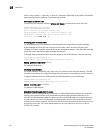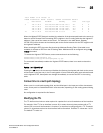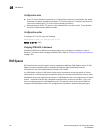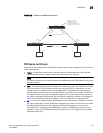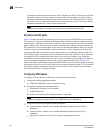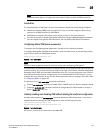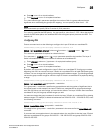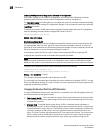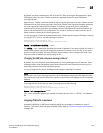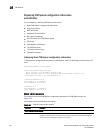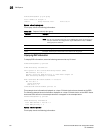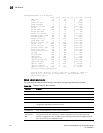
748 PowerConnect B-Series FCX Configuration Guide
53-1002266-01
PIM Sparse
25
Updating PIM-Sparse forwarding entries with new RP configuration
If you make changes to your static RP configuration, the entries in the PIM-Sparse multicast
forwarding table continue to use the old RP configuration until they are aged out.
The clear pim rp-map command allows you to update the entries in the static multicast forwarding
table immediately after making RP configuration changes. This command is meant to be used with
rp-address command.
To update the entries in a PIM sparse static multicast forwarding table with new RP configuration,
enter the following command at the privileged EXEC level of the CLI.
PowerConnect#clear pim rp-map
Syntax: clear pim rp-map
Statically specifying the RP
Dell recommends that you use the PIM Sparse protocol RP election process so that a backup RP
can automatically take over if the active RP router becomes unavailable. However, if you do not
want the RP to be selected by the RP election process but instead you want to explicitly identify the
RP by its IP address, you can do using the following CLI method.
If you explicitly specify the RP, the Layer 3 Switch uses the specified RP for all group-to-RP
mappings and overrides the set of candidate RPs supplied by the BSR.
NOTE
Specify the same IP address as the RP on all PIM Sparse routers within the PIM Sparse domain.
Make sure the router is on the backbone or is otherwise well connected to the rest of the network.
To specify the IP address of the RP, enter commands such as the following.
PowerConnect(config)#router pim
PowerConnect(config-pim-router)#rp-address 207.95.7.1
Syntax: [no] rp-address <ip-addr>
The <ip-addr> parameter specifies the IP address of the RP.
The command in the example above identifies the router interface at IP address 207.95.7.1 as the
RP for the PIM Sparse domain. The Layer 3 Switch will use the specified RP and ignore group-to-RP
mappings received from the BSR.
Changing the Shortest Path Tree (SPT) threshold
In a typical PIM Sparse domain, there may be two or more paths from a DR (designated router) for
a multicast source to a PIM group receiver:
• Path through the RP – This is the path the Layer 3 Switch uses the first time it receives traffic
for a PIM group. However, the path through the RP may not be the shortest path from the Layer
3 Switch to the receiver.
• Shortest Path – Each PIM Sparse router that is a DR for a multicast source calculates a
shortest path tree (SPT) to all the PIM Sparse group receivers within the domain, with the Layer
3 Switch itself as the root of the tree. The first time a Layer 3 Switch configured as a PIM router
receives a packet for a PIM receiver, the Layer 3 Switch sends the packet to the RP for the
group. The Layer 3 Switch also calculates the SPT from itself to the receiver. The next time the
Layer 3 Switch receives a PIM Sparse packet for the receiver, the Layer 3 Switch sends the
packet toward the receiver using the shortest route, which may not pass through the RP.



